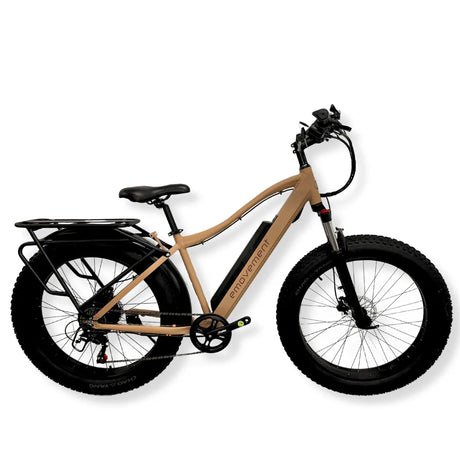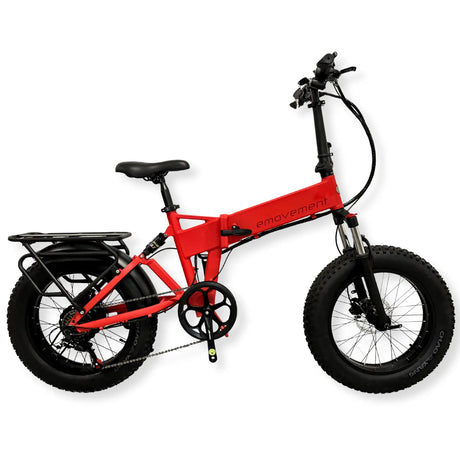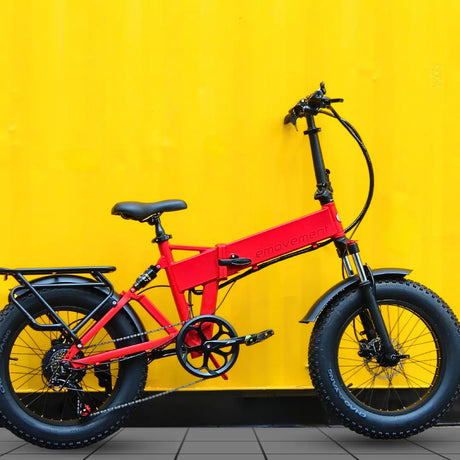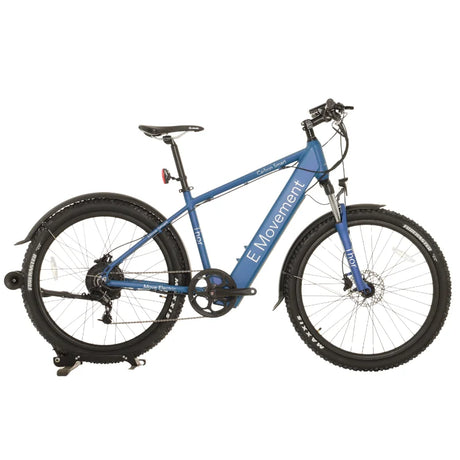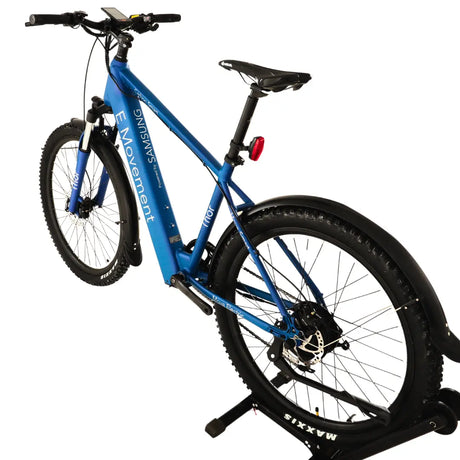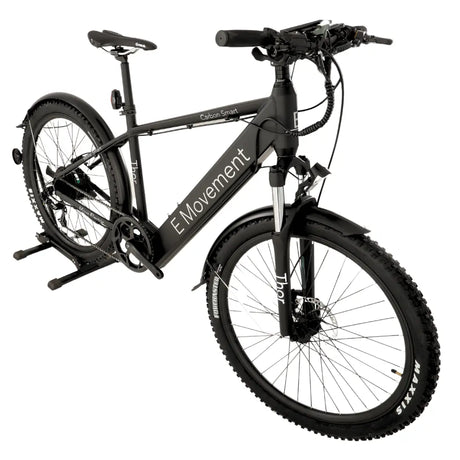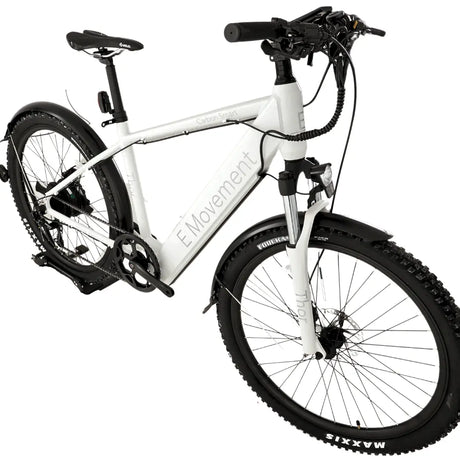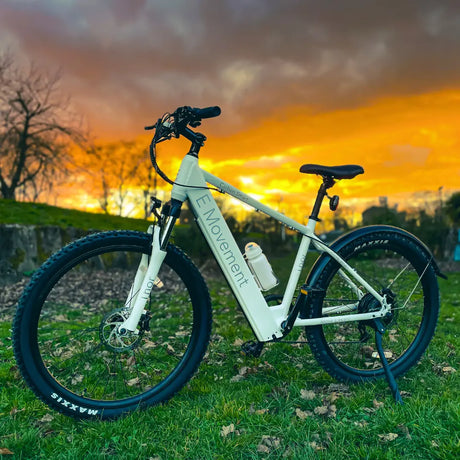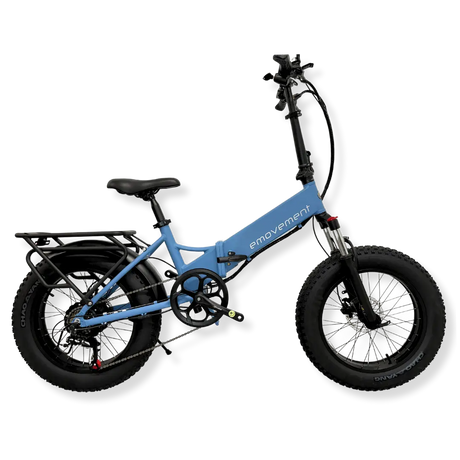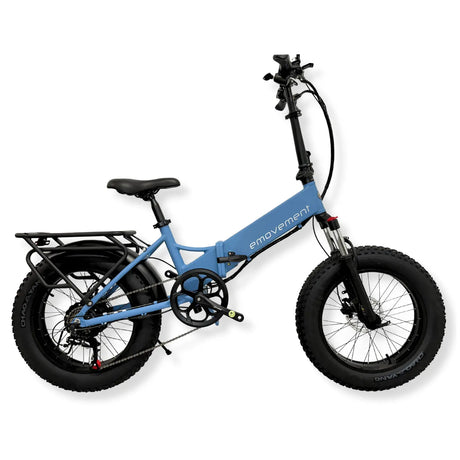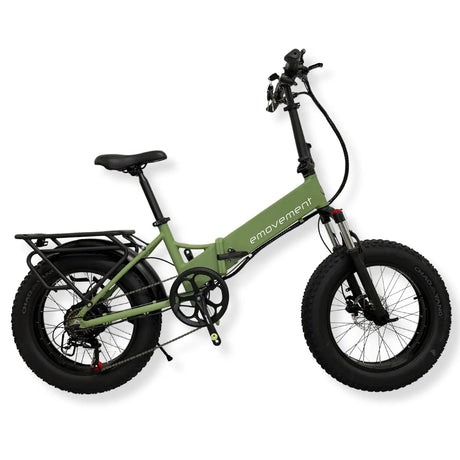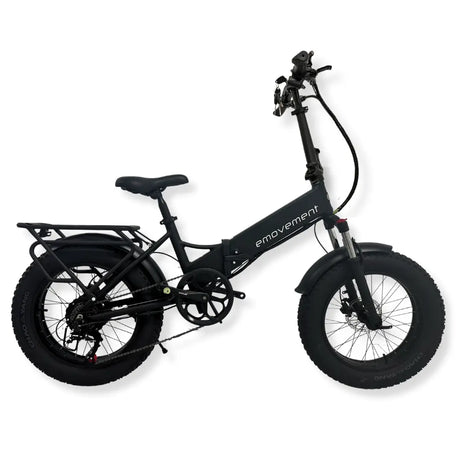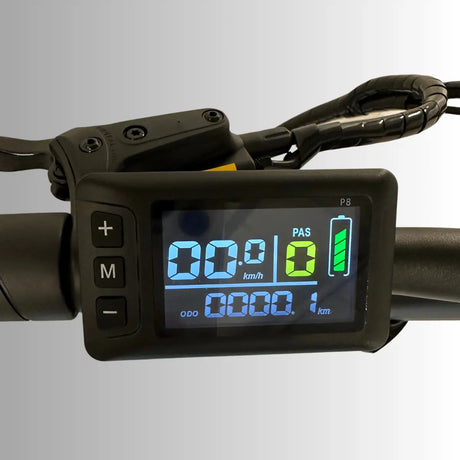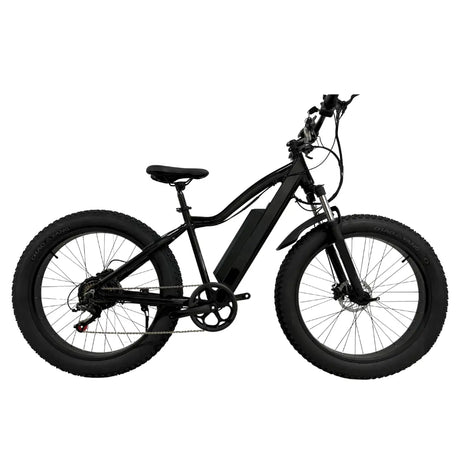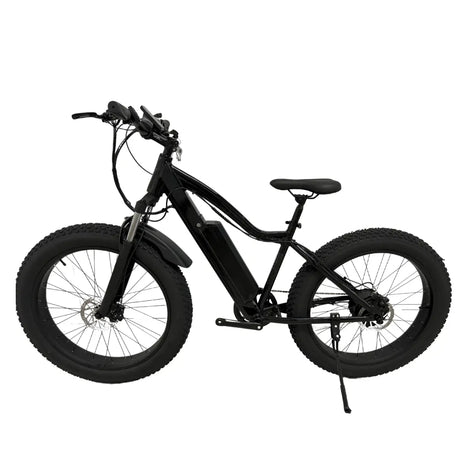Inside this Article:
- E-Bike Terminology You Need to Know Before Buying
- I. Motor Power and Watts
- II. Battery Capacity
- III. Step-Through or Step Thru
- IV. Folding Electric Bikes
- V. Hybrid Bikes
- VI. Commuters or E-Road bikes
- VII. Mountain Bikes
- VIII. Suspension Systems
- IX. Financing
- X. Hub Motor
- XI. Pedal Assist
- What to Assess and Look for an E-Bike?
- 1. Price and Financing Options
- 2. Intended Use and the Types of Electric Bikes
- 3. Motor Type, Voltage, and Power
- 4. Battery Ratings
- 4. Pedal-Assist Levels
- 5. Frame Type and Size
- 6. Brakes and Suspension
- 7. Components and Accessories
- 8. Test Ride, Company Reputation and Reviews
- 9. Frame Material, Manufacturing Quality, and Water and Dust Proofing
- 10. Warranty and After-Sales Support
- Endnote
- FAQs
E-bikes have taken the world by storm in recent years due to their accessibility, ease of use, and sustainability. Their convenience and practicality over regular bikes, combined with them being more nimble, silent and budget-friendly, and eco-friendly than vehicles is incredibly advantageous. Whether you want to explore rugged terrains or navigate traffic during rush hour, this mode of transportation will take you almost anywhere without a hitch.
Choosing the perfect electric bike for yourself can be challenging because there are various models and specs available for different riding experiences. And of course, it requires a considerable monetary investment. But fear not because we’re here to help, so keep reading as we tell you where and why to buy an electric bike .
E-Bike Terminology You Need to Know Before Buying
Buying an electric bike is slightly more complicated than buying a normal bike because of the additional components, features and specifications.
Here’s a list of common electric bike-related terms you should be aware of before investing in one:
I. Motor Power and Watts
An electric bike motor provides electrical assistance to your pedalling and determines your speed and acceleration
A 250-watt motor is suitable for road-legal e-bikes, meaning it meets the power requirements set by regulations for use on public roads in the UK. This motor provides enough power to assist your pedalling, making it easier to ride uphill or travel longer distances with less effort. It is ideal for daily commuting and leisurely rides on paved surfaces.
Motors rated higher than 250 Watts like 500, 750 1000W motors are designed for off-road e-bikes, which are intended for use on rugged terrain, trails, and adventurous paths. This higher-power motor delivers increased torque and acceleration, enabling you to tackle hills and rough surfaces with confidence. They are perfect for thrill-seekers who enjoy exploring challenging landscapes and off-roading adventures.
II. Battery Capacity
A battery’s capacity refers to how much energy a battery can store, which directly impacts how long your electronic device or vehicle can operate before needing a recharge. It is usually expressed in either Ah or Watt-hours (Wh) and is a crucial factor to consider when purchasing batteries.
Ampere-hours represent the amount of charge a battery can deliver over time. The higher the Ah rating, the longer your e-bike can run on a single charge. For example, a battery labelled as “X Volts -Y Ah” means it can supply X volts and has the capacity to deliver Y ampere-hours of charge. You will commonly find electric bikes having batteries between 7 to 15 Ah.
Watt hours (Wh) indicate the total energy capacity of a battery and take into account both the voltage and the Ampere-hours. It gives you a more comprehensive understanding of the battery’s performance. If you see a battery labelled as “X*Y Wh,” it means the battery can deliver X volts and has a total energy capacity of Y watt-hours.
III. Step-Through or Step Thru
A step-through e-bike , also known as a step-thru bike, is a type of electric bike designed with a low top tube or no top tube at all – just a down tube – enabling easy mounting and dismounting. This unique frame design allows riders to easily step into and out of the bike without having to swing their leg over the top tube.
Step-through bicycles are particularly popular among people who value ease of mounting and dismounting , especially those who aren’t as flexible or prefer wearing tight clothing, skirts, dresses, or are older riders. They are popular as approachable and accessible cycling options.
IV. Folding Electric Bikes
Folding electric bikes can be easily folded into a compact size for convenient storage and portability, making them the ultimate space-saving solution. They are ideal for commuters, travellers, and those with limited storage space. You can often easily take them on public transport, store them indoors, or even bring it along in your car’s boot for your adventures. However, note that they may not always be lightweight in nature. In fact, very lightweight folding e-bikes are usually not as sturdy and are only suitable for roads
V. Hybrid Bikes
Hybrid electric bikes are versatile and well-rounded bicycles that combine the best features of road bikes and mountain bikes. They are designed to offer a comfortable and efficient riding experience on various terrains, including city streets, bike paths, and light trails. With a sturdy frame, wider tires, and an upright riding position, hybrid bikes provide a smooth and stable ride for everyday use and recreational cycling.
VI. Commuters or E-Road bikes
Commuter electric bikes are designed for daily city commuting. These bicycles offer comfort, efficiency, and practicality, making them perfect for navigating busy streets, bike lanes, and traffic. With features like a comfortable upright riding position, durable frames, fenders to keep you clean in wet weather, and racks or baskets for carrying your belongings, commuter e-bikes offer a smooth and convenient ride to work, school, or any other destination in your city. Whether you’re a regular commuter or just looking for a practical way to get around town, a commuter bike is a reliable and eco-friendly choice for your daily transportation needs.
VII. Mountain Bikes
E-Mountain bikes are rugged and versatile bicycles designed for off-roading and challenging terrains. These bicycles feature sturdy frames, knobby tires with excellent traction, and front suspension forks (and sometimes full suspension) to absorb shocks and bumps on rough trails. They come with a wide range of gear options that allow you to conquer steep inclines and navigate through various obstacles with ease. So, they are perfect for outdoor enthusiasts who enjoy exploring trails, mountains, and forests.
Whether you’re a beginner or an experienced rider, a mountain bike is an ideal choice for embracing the great outdoors and experiencing the joy of off-road cycling.
VIII. Suspension Systems
Suspension systems absorb shocks in an electric bike. Electric bikes equipped with these have special components (such as front forks or rear shock absorbers) that mitigate impacts from uneven terrain, providing a more comfortable and controlled ride.
Suspension is particularly beneficial when riding on trails, gravel paths, or rough roads, as it reduces the impact on your body and enhances overall stability. For those seeking a smoother and more enjoyable cycling experience, a bike with suspension is a great choice, especially for off-roading and bumpy terrains.
IX. Financing
Financing refers to the availability of instalment options for purchasing an electric bike. Instead of paying the full amount upfront, financing allows you to divide the cost of the electric bike into smaller, more manageable monthly payments. This makes it easier for you to afford your electric bike without straining your budget. With financing options, you can enjoy the benefits of owning an electric bike and start using it right away, while spreading the cost over a period of time.
X. Hub Motor
A hub motor is a type of electric motor used which is directly integrated into either the front wheel or rear wheel hub . Unlike a conventional motor, it eliminates the need for a chain or belt, making it a clean and low-maintenance option. When you pedal or engage the throttle with a hub motor, it provides electric assistance, giving you an extra boost to make pedalling easier and more efficient. These motors are known for their simplicity, quiet operation, and ease of use, making them a popular choice for beginners and casual riders seeking a seamless electric biking experience.
Note that front hub motors are riskier as compared to rear wheel ones.
XI. Pedal Assist
Pedal assist, also known as electric assistance is a feature found in electric bicycles that assists your pedalling efforts. In electric bikes, without throttle, when you start pedalling, the pedal assist kicks in and provides an extra boost, making it easier to pedal and ride with less effort. You can adjust the level of assistance to suit your preference. Pedal assistance is a fantastic option for riders who want to enjoy the benefits of electric assistance while still getting some exercise and control over their riding experience.
If you want a more detailed glossary and explanation of the parts of an electric bike, you can visit this article.
What to Assess and Look for an E-Bike?
If you want to find an electric bike worth your investment, you need to consider your preferences and needs. Aspects like your budget, riding terrain, weight, etc., all contribute to your riding experience.
Let’s begin with the obvious: the price.
1. Price and Financing Options
Electric bike prices can vary significantly depending on the brand, model, features, and quality, so you will have to determine your budget range for purchasing one. When you set a budget, you can narrow down your options and find the best e-bike within your price range online or at nearby local shops.
We don’t recommend going for cheaper companies for your new e-bike as they typically aren’t VAT registered and their bikes can stop working within months. These companies appear in markets with prices that are too good to be true, sell out their low-quality products fast, and then disappear from the surface of the earth, leaving you with bicycles that go bad with no brand to chase.
Perhaps you’re tight on budget. In that case, going for brands’ ex-demo/ ex-display e-bikes can be a great idea. Ex-demo bicycles often come with warranties (at least ours do!), and you can be sure they have been used under supervision. Buying directly from another person is also an option, but just make sure you check the battery’s condition thoroughly – best to get the bike professionally inspected after purchasing.
If you don’t trust others easily and are still tight on budget, consider saving up a bit and going for e-bike sales – Easter, Christmas, and mid-summer sales are popular in the e-bike world.
Additionally, the UK government’s Cycle to Work scheme is incredibly convenient; it allows you to save up to 47% while letting you pay your employer in instalments cut directly from your salary. If your employer is stingy and not registered with any scheme, you can try convincing them of its benefits through our detailed guide on this scheme . Or you can purchase your e-bicycles in instalments through solutions like Snap Finance and Klarna .
2. Intended Use and the Types of Electric Bikes
Determine how you plan to use the electric bicycle before searching for different models. Will it be primarily for commuting, recreational purposes, off-road adventures, or a combination? As we mentioned earlier, different elect bike models are designed for specific purposes, such as city commuting bikes, electric mountain bikes, folding bikes or hybrid models. Your area’s laws will vary depending on your use as well. For instance, you cannot legally use an e-bike with a power above 250W on UK roads – it doesn’t classify as an EAPC.
It’s worth noting that any type of e-bike can be used on roads, whether you choose a fat bike, a mountain e-bike, a hybrid, or a commuter. However, road-specific e-bicycles are generally lighter and sleeker, allowing for swift rides. Smaller tyres can give you high manoeuvrability in city corners whereas larger tyres offer more responsiveness , allowing you to exert less force and get smoother turns. However, not every area has perfect, smooth, paved roads and those areas
3. Motor Type, Voltage, and Power
There are two main types of powerful motors for most electric bikes; hub motors and mid-drive motors (also called mid-mounted or central drive motors). Hub motors are further divided into front hub and rear hub motors.
Among these, front hub motors are the riskiest – the added weight on the front tyre can make turning in speed very difficult and holds the risk of knocking you off the bike. Consequently, people and manufacturers alike avoid them. In contrast, mid-drive systems are the most efficient , enabling perfect weight balance. But keep in mind that they are expensive. And if you want the best of both worlds? Look no further than r ear hub motors that offer both price efficiency and safety .
Motor ratings are also incredibly important, as they determine your acceleration and speed. Generally, a higher motor rating provides the electric motor with more power and helps riders reach higher speeds for a more dynamic and responsive riding experience.
Two common motor voltage ratings are 36V and 48V. Anyone seeking a faster and more powerful ride should opt for a 48V motor. Not only does this rating result in improved speed and acceleration for the electric bike, but it also ensures considerable control over steep inclines or mountainous terrain. On the other hand, a 36V voltage rating is more suitable if you prefer longer ranges over higher speeds, as lower voltage batteries have a higher capacity to cover more ground.
Remember that your state or country will also have laws governing the maximum electric motor rating you can use on roads. In the UK, e-bikes above 250W need to be licensed, taxed, and insured just like mopeds, and not doing so can result in heavy fines .
4. Battery Ratings
To make the most out of an electric bike, you have to take into account how long your battery life lasts on a single charge. This is majorly determined by the battery’s capacity, although, of course, your preferred pedal assistance levels, your speed and weight, and the terrain’s incline play a part too.
You’ll find electric bike batteries ranging from 7Ah onwards in the market. An e-bike’s range is complicated to calculate, but we can make some general estimates.
As our tests with our Panther indicate, a 14Ah battery on a full-suspension ebike with a 75kg rider can go up to 70 miles on plain London roads if you’re using pedal assist level 1/5 on a 28 kg bike . Roughly speaking, that’s a combined bike+rider weight of 100kgs. Extending this and assuming linear relation gives us:
|
E-Bike Battery |
Maximum Range (battery life) for 75kgs Rider Weight |
|
7Ah |
35 miles |
|
10Ah |
50 miles |
|
12.8Ah |
64 miles |
|
14Ah |
70 miles |
|
20 Ah |
100 miles |
|
27 Ah |
135 miles |
Maximum Range (battery life) of a full suspension electric bike for 100kgs combined Rider+Bike weight
Bear in mind that these calculations are estimates for a combined bike and rider weight of 100kgs. Factors like battery health, pedal assistance, weight, difficulty of terrain, speed, and incline can all affect them.
4. Pedal-Assist Levels
Electric bicycles usually come with multiple pedal-assist levels, allowing you to adjust the level of assistance provided by the motor. It’s in your best interest to determine how many assistance levels are offered and their alignment with your preferred riding style and fitness level. The greater the number of levels you can select between, the more flexibility you’ll have to customise your riding experience and utilise the battery power.
For example, our e-bikes offer 5 pedal assist levels, with 1 indicating the least electrical assistance to 5 indicating the most. This means that using level 1 gives you the longest range and level 5 the least. We recommend going for electric bikes with at least 3 pedal assistance levels to make the most out of your bike depending on your stamina levels.
5. Frame Type and Size
Just like with a regular bike, an e-bike’s frame is its backbone and there are various designs to choose from. These include step-through, diamond, or folding frames.
Your frame design should suit your comfort, ease of mounting and dismounting, and riding preferences. You’ll also have to ensure that you select an appropriate frame size to fit your body proportions for a comfortable and proper riding posture. All e-bikes have minimum height and maximum weight ratings, so make sure you heed them.
If you struggle with mobility issues or prefer wearing tighter attire, opt for step-through frames. Similarly, if you’re large in stature, fat e-bike frames can suit you more compared to fragile road e-bikes.
Make sure you check the height and weight specifications of the e-bike you want to purchase. For instance, shorter riders (down to 4.8ft) can opt for our Hunter Extreme 20Ah as we can cut down the bike’s seat post for them.
6. Brakes and Suspension
Good brakes are essential for electric bikes. Since these bicycles can be fast, it is crucial for them to integrate brakes that can stop the e-bike quickly and safely. Hydraulic disk brakes are generally considered safer here than mechanical brakes.
As for suspension, you’ll find four main types: rigid bikes, front suspension, full suspension, and fat-tyre suspension. You should:
- Go for rigid e-bikes if you’re low on budget and only intend to use your electric bikes for urban riding, such as on smooth roads.
- Opt for front suspension hardtail frames if you just need your e-bike on city streets, bike paths, and mild off-road paths.
- Consider full-suspension electric bikes for the smoothest rides on bumpy paths, steep hills and off-road trails. They’re incredible on the road too.
- Invest in a fat-suspension bike (your regular fat e-bike) if you prefer a chunkier frame and smoother ride. Fat-suspension bikes are the most effective on loose terrains, like sand and snow.
7. Components and Accessories
Did you know that parts such as fenders, racks, a handlebar-mounted computer, etc., are often not attached to the bikes and may have to be bought separately? Check whether your e-bike comes with any accessories or you’ll need to buy them again. The most critical parts include:
- lights
- fenders
- Front baskets and rear racks
- kickstand
Locks and battery covers are also incredibly useful extras that some companies (like us) include with bikes! Reliable and durable components contribute to a smooth and safe electric bike ride experience.
8. Test Ride, Company Reputation and Reviews
Whenever possible, take the opportunity to test-ride different electric bike models and compare price points before making a decision. This will enable you to experience the ride, handling, weight distribution, and comfort firsthand. In cases when this isn’t possible, read reviews and seek opinions from other e-bike owners or experts to gather insights and learn from their experiences.
Unlike their own websites, businesses often can’t manipulate their reviews on platforms like Google Business. Youtube videos about unboxing or influencer content can also be a reliable source to determine which company’s electric bike is the perfect fit for you. So, make sure you purchase from a company that’s well-reputed among bike enthusiasts and old customers.
9. Frame Material, Manufacturing Quality, and Water and Dust Proofing
You need to ensure your electric bike is composed of a material that suits your usability and preferred terrain.
Most bicycles are made of aluminium, titanium steel, and carbon fibre. Aluminium and carbon fibre are incredible at balancing strength, lightness, and affordability. Steel is heavier but incredibly strong, whereas titanium is excellent but pretty expensive.
Alongside the materials, the bike’s quality and waterproofing capabilities are also critical – especially in the UK where you see all sorts of rain and snow.
10. Warranty and After-Sales Support
Check the warranty offered by the manufacturer or retailer to understand the coverage provided for the pedelec components, motor, and battery. Also, consider the availability of after-sales support, including maintenance, repairs, and spare parts. A reputable brand that provides good warranty coverage and reliable customer support can offer peace of mind and assistance in case of any issues.
After-sales support and the availability of spares is why we always advocate for local companies instead of international ones – you can claim warranties easily and take your e-bike to them in case of any damage.
Endnote
Since buying your first e-bike can be a big and potentially expensive decision, it’s essential to do research and determine the right fit for you according to your riding needs and preferences. You can go through our articles on how electric bikes work and their various parts if you need more information. And don’t hesitate to contact us with any queries or concerns you have regarding our e-bike models or services.
FAQs
1. How Do Electric Bikes Work?
An electric bike is like a normal bike with a motor to push it forward. It works on three crucial components: the motor, the batter, and the sensor. The motor gives you a boost while riding and is powered by the battery. When you start pedalling, the battery runs and the sensor engages the built-in motor to start working in the same way.
2. Why Buy an E-Bike?
Electric bikes offer several benefits over standard bikes for both riders and the environment. Not only do e-bikes work on greener energy means (than fossil fuels) that reduce the rider’s carbon footprint, but they’re also fast and cheaper than cars or other vehicles. Depending on your pedal assistance level, you can also get in regular workouts to improve your well-being and stay fit. To read more about e-bike’s advantages, you can go through our article: Are E-Bikes Worth It?
3. What Types of E-Bikes Are Available?
There are different types of electric bikes to choose from, such as commuters (road bikes), hybrids, mountain e-bikes, etc. For instance, mountain electric bikes typically feature fat tyres and are great for off-road trails and rugged regions. If you want to breeze past traffic during rush hour, opt for a Commute road bike or purchase a hybrid that you can also ride up hills in the evenings. Depending on the company, these bikes also come in step-through and folding frames for your convenience and comfort.
4. Are Electric Bikes Legal?
You need to be at least 14 years old to legally ride an e-bike in the UK. Electric bikes with a maximum power output of 250 watts don’t require a driving licence and can be used on roads and bike lanes. In contrast, bikes with a motor rating greater than 250 watts have to be licenced, registered, and insured.
5. How Fast Can E-bikes Go?
According to UK e-bike laws, pedelecs can only assist you up to a top speed of 25 kph. Most manufacturers restrict their electric bikes to 25KPH. However, unrestricted bikes can go up to 45 KPH or more. If you exceed your state’s maximum speed limit, you are likely to be fined or charged with careless or dangerous driving.




